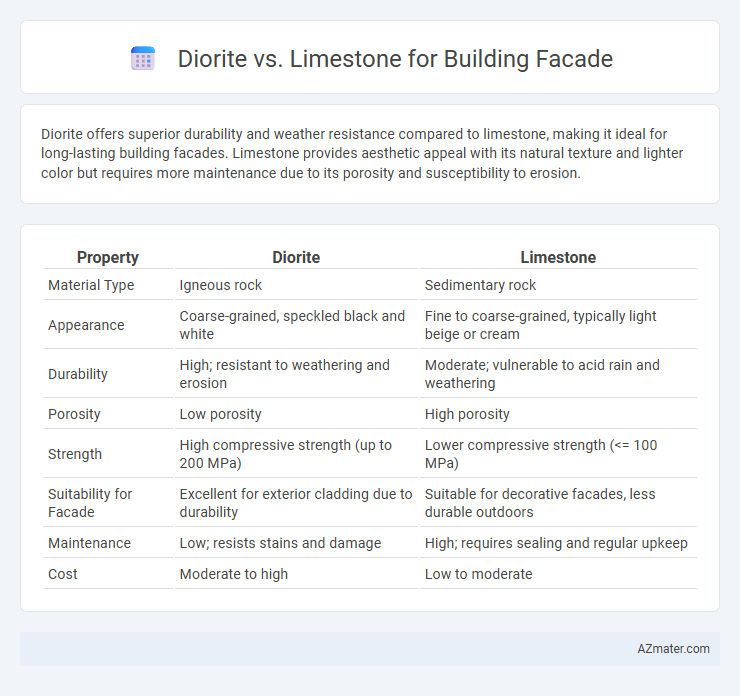Diorite offers superior durability and weather resistance compared to limestone, making it ideal for long-lasting building facades. Limestone provides aesthetic appeal with its natural texture and lighter color but requires more maintenance due to its porosity and susceptibility to erosion.
Table of Comparison
| Property | Diorite | Limestone |
|---|---|---|
| Material Type | Igneous rock | Sedimentary rock |
| Appearance | Coarse-grained, speckled black and white | Fine to coarse-grained, typically light beige or cream |
| Durability | High; resistant to weathering and erosion | Moderate; vulnerable to acid rain and weathering |
| Porosity | Low porosity | High porosity |
| Strength | High compressive strength (up to 200 MPa) | Lower compressive strength (<= 100 MPa) |
| Suitability for Facade | Excellent for exterior cladding due to durability | Suitable for decorative facades, less durable outdoors |
| Maintenance | Low; resists stains and damage | High; requires sealing and regular upkeep |
| Cost | Moderate to high | Low to moderate |
Introduction to Diorite and Limestone
Diorite is a coarse-grained igneous rock known for its durability and speckled appearance, composed primarily of plagioclase feldspar and amphibole minerals, making it highly resistant to weathering and ideal for building facades demanding longevity. Limestone, a sedimentary rock chiefly made of calcium carbonate, offers a softer texture and lighter color palette with excellent workability, often chosen for intricate architectural details and classical finishes. Both materials present distinct aesthetic and functional benefits, with diorite providing strength and longevity, while limestone delivers versatility and timeless elegance for facade applications.
Geological Formation and Composition
Diorite, an intrusive igneous rock formed from the slow cooling of magma beneath the earth's surface, consists mainly of plagioclase feldspar and hornblende, giving it a coarse-grained texture and high durability ideal for building facades. Limestone, a sedimentary rock composed primarily of calcium carbonate from accumulated marine organisms, presents a softer, more porous structure that is susceptible to weathering but offers excellent workability and aesthetic appeal. The contrasting geological formations and mineral compositions significantly influence their performance and maintenance requirements in architectural applications.
Aesthetic Appeal: Color and Texture Comparison
Diorite offers a striking aesthetic appeal with its coarse-grained texture and salt-and-pepper coloration ranging from dark gray to black with white specks, creating a visually dynamic facade. Limestone provides a softer, more uniform appearance with smooth texture and warm, earthy tones including creamy beige, light gray, and soft yellows, lending an elegant and classic look to building exteriors. The choice between diorite and limestone for building facades depends largely on the desired visual impact--diorite's bold contrast suits modern, dramatic designs, while limestone's subtle hues complement traditional and timeless architecture.
Durability and Weather Resistance
Diorite exhibits exceptional durability and superior weather resistance compared to limestone, making it ideal for building facades exposed to harsh environmental conditions. Its dense, coarse-grained texture resists erosion, moisture absorption, and freeze-thaw cycles better than the softer, more porous limestone. Limestone, while aesthetically versatile, is more prone to surface degradation and chemical weathering, requiring regular maintenance to preserve its integrity on exterior facades.
Workability and Installation Methods
Diorite offers high durability and resistance but is challenging to work with due to its hardness, requiring specialized cutting tools and skilled labor for installation on building facades. Limestone provides greater workability because of its softer texture, allowing easier shaping and carving, which simplifies installation using conventional masonry techniques. Selecting between diorite and limestone depends on balancing the facade's design complexity and long-term maintenance needs with the installation labor intensity and cost.
Cost Factors and Availability
Diorite, a dense and durable igneous rock, typically incurs higher costs for building facades due to its limited availability and challenging quarrying process. Limestone, abundant and easier to extract, generally offers a more economical option with lower transportation and processing expenses. Cost factors for both materials are influenced by regional supply, quarry proximity, and required finishing techniques.
Environmental Impact and Sustainability
Diorite offers higher durability and weather resistance compared to limestone, resulting in longer-lasting facades with reduced maintenance and replacement needs, which lowers the overall environmental footprint. Limestone, while less durable, is often sourced locally and is easier to quarry and process, reducing transportation emissions and energy consumption. Both stones are natural and recyclable, but careful selection based on project location and lifespan can optimize sustainability in building facades.
Maintenance Requirements
Diorite exhibits exceptional durability and weather resistance, resulting in minimal maintenance requirements for building facades, as it resists chipping, staining, and erosion. Limestone, while aesthetically pleasing, demands more frequent upkeep, including sealing and cleaning, to prevent surface degradation and staining due to its porous nature. Choosing diorite reduces long-term maintenance costs, whereas limestone requires consistent effort to preserve its appearance and structural integrity.
Notable Architectural Examples
Diorite is showcased in renowned structures like the Pantheon in Rome, where its durability and speckled appearance create a striking facade with lasting elegance. Limestone features prominently in the iconic Notre-Dame Cathedral in Paris, prized for its ease of carving and warm, natural tones that enhance intricate Gothic details. Both materials serve distinct aesthetic and structural purposes, with diorite providing robustness and limestone offering sculptural versatility in historic architecture.
Choosing the Right Stone for Your Building Facade
Diorite offers exceptional durability and a unique speckled appearance, making it ideal for building facades exposed to harsh weather conditions. Limestone provides a softer, more uniform texture that lends a classic, elegant look but may require more maintenance due to its susceptibility to weathering and acid rain. Selecting the right stone depends on balancing aesthetic preferences with environmental factors and long-term durability needs for your building facade.

Infographic: Diorite vs Limestone for Building Facade
 azmater.com
azmater.com